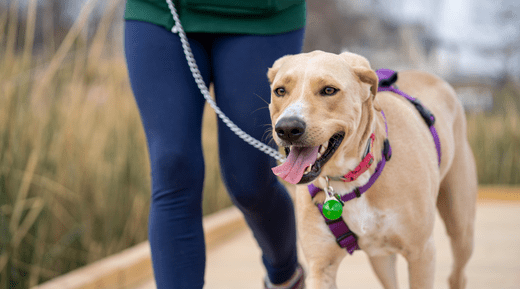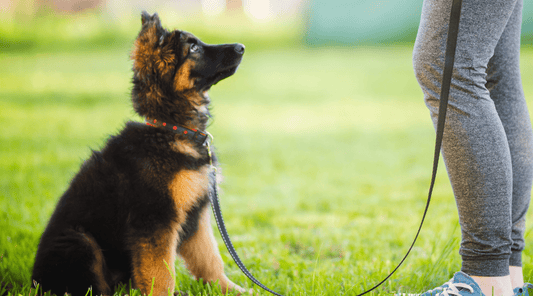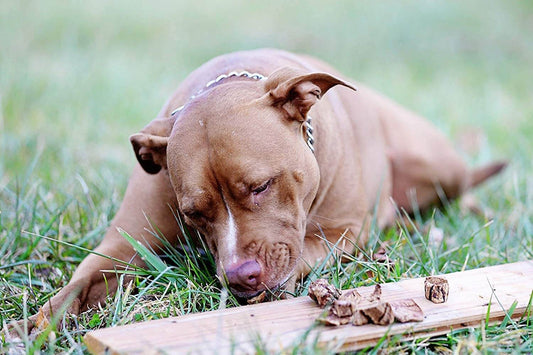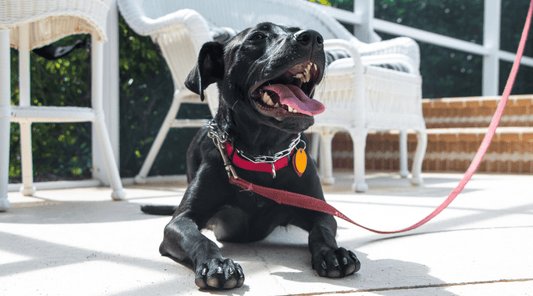
Understanding Canine Obesity: Tips for a Healthy Weight
Dawn Miller Jan 10, 20255 Minute ReadIn the US, an estimated 59% of dogs have canine obesity, and it's even worse for cats, at 61%. Learning how to help a dog lose weight safely, prevent excess weight gain, and enhance dog nutrition are critical skills every dog parent needs to know.
The other evening, I was on a stroll with my lab mix, Bruno, and my neighbor’s golden retriever, Maisy. Maisy is a sweetheart who never meets a stranger. And she's also becoming more rotund as she ages.
"She's not lazy," Emma assured me without any judgment on my part.
I didn't think she was lazy. I realize that unwanted weight gain is a complex issue.
"I think I've been spoiling her with too many treats." Emma confessed. The conversation sparked a very in-the-moment chat about canine obesity, its risks, and what we, as dog parents, can do to keep our pups at a healthy weight—without depriving them.
Why Canine Obesity Is a Big Problem
Why does it matter?
For so long, we were told to focus on the "aesthetics" of weight gain. Over the past decade, more people have rejected that narrative, and I think we should. But as we did, it became clear we needed to talk about what carrying extra weight does to dog health.
It's not about looks. Canine obesity causes (and worsens) health problems that would not exist without it—or at least not until they were old.
Joint Problems
Extra weight puts more stress on a dog’s joints, leading to arthritis and mobility challenges, especially in senior dogs. I was actually shocked to learn that jumping generates a force on the knees of 5X body weight.
So, if a dog weighs 60+ pounds like my lab mix, Bruno, Wow!
Heart Disease
Just like humans, overweight dogs are at risk for heart issues. The heart has to work harder to get blood everywhere it needs to go. They may also have elevated blood pressure, forcing the heart to pull a double shift to keep the body oxygenated.
Like me, when I worked a ton of overtime, eventually, it burns out.
Diabetes
Obesity increases the likelihood of developing insulin resistance, which leads to diabetes. This condition is costly and challenging to manage. I'm not a big fan of needles. Are you?
Imagine having to prick, test, and inject your dog with insulin 2-3 times a day. No fun!
Then you accidentally give them too much. And they go into a coma. This happened to a family member and her cat. The cat survived. But my family member has been beating herself up about it ever since.
Reduced Lifespan
According to the American Veterinary Medical Association, overweight dogs live an average of 2.5 years less than their healthy-weight counterparts.
Lab mixes like my Bruno can live upwards of 15 healthy, active years with the right nutrition and support. But the average lab doesn't make it past 12, with those last few years spent sick.
Emma was surprised to learn about the lifespan impact. "I don’t want to lose Maisy early just because I gave her too many dog treats," she admitted.
I assured her that dog treats could be part of the problem. But in addition to managing treat time effectively, there were other steps to help a dog lose weight.
How to Help a Dog Lose Weight
1. Portion Control
Dogs often eat as much as you give them. So, it's important to check the label to see what an appropriate serving of your dog food of choice is. It varies.
Don't free pour it. Always measure.
2. Choose High-Value Food
Higher-quality foods may seem expensive. But they often require smaller portion sizes because they contain less filler and are more nutrient-dense.
So, choose the highest quality food you are able to buy. What your dog deserves, you can give.
Also, remember that you'll save on vet bills when you commit to improving dog nutrition and health.
3. Dog Food Portion Size Is a Rough Estimate
This amount is usually based on a dog's weight. But if your dog is already overweight, this may be too much for weight loss.
Start at the amount the bag says. Slowly lower it to the amount for their ideal weight.
If your dog is currently at a healthy weight, start with what the bag says and lower it a little. If your dog still seems satisfied and isn't becoming underweight, that's probably what they need.
4. Make Treats No More than 10% of Calories
Add up all of the treats, including the healthy ones, training dog treats, I-love-you treats, and dog bones. According to the American Kennel Club, keep treats under 10%.
5. Choose Healthy Dog Treats
High-value dog treats are irresistible for dogs but also super nutritious, with no fillers or ingredients I can't pronounce. Ideally, they're single ingredient, too.
For example, dogs love beef. So, single-ingredient treats from beef cattle, such as organ meat, connective tissues, and dog bones, are perfect.
I schedule chew sessions 2X a week with a high-value dog chew bone like a K9 Connoisseur grass-fed beef marrow dog bone.
That dog bone helps my dogs clean their teeth while feeling entertained, mentally stimulated, and generally well. High value marrow-filled dog bones also support nutrition with extra protein, healthy fats, and electrolytes that can keep pups feeling active and healthy so they play more; mope less.
In addition to dog bones, I keep beef trachea in the dog health rotation. This is mostly cartilage. So, it's chewy but also lasts a long time.
Cartilage is packed with collagen plus glucosamine and chondroitin to keep joints mobile and dogs active.
6. Encourage Regular Activity (My Dog Exercise Tips)
It's good for them and you. Try going for longer walks, taking them to the park, and playing fetch or tug-of-war in the backyard.
Make being active and engaged in life feel second nature. Because being active is the natural state for dogs, it makes them feel well and promotes a healthy weight in dogs.
We're the ones who decided they needed to stay inside most of the time. And we can change that with more time spent on activities.
I encouraged Emma to start training Maisy. The golden already knows to sit and stay. I also shared that Maisy can learn many more skills to be more active.
Maisy was hesitant at first. So, I showed Emma how to use healthy dog treats to promote more physical activity without worsening the problem.
I recommended she check out this Free 7-Day Dog Training Challenge from K9 Connoisseur. It shows pet parents how to bond with their dogs and interact with them in healthy and active ways. It starts with the basics and advances to those fun party tricks my terrier Pixie is fond of showing off to guests.
Maisy: A Healthier, Happier Pup!
Maisy and Emma are doing well. They train several times a week, and Emma is becoming more mindful of the quality of treats and kibble she gives her. She also decided to switch to single-ingredient dog bones and treats for better weight management and dog health.
Obesity doesn’t have to shorten your dog’s lifespan. With a little effort, you can keep your furry friend happy, healthy, and active one chew, training, or fetch session at a time.
Available On:





